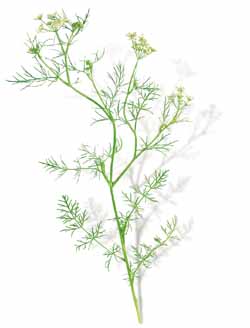Caraway Seeds
The caraway plant is a biannual. This means it takes two years for the plant to mature, produce seeds, then die. In practical terms, you start the plants two years in a row from seed. You won't get seeds until the second year so starting them two years in a row will give you an ongoing crop.
During the winter you may not see any evidence of the plant even though the roots are preparing for spring. Mark your spot carefully so you don't accidentally dig them up in the spring. Caraway will grow about 8 inches the first year and up to 24 inches in the second.
Seeds can be started early indoors, or can be sown directly where they are to grow. The plant prefers warm, sunny locations and well-drained soil rich in organic matter. In warmer regions it is planted in the winter months as an annual.
Grow in light, fertile, well drained soil. Plant 18 inches apart in a position that receives plenty of sunlight. Caraway prefers a sandy soil with good drainage, clays or wet soils are not going to grow a good plant and they may die over the winter.
If started indoors, sow into small pots containing good quality seed starting mix. The plant has a long taproot which, once grown is difficult to transplant, so if sown early, transplant to the garden as soon as you are able while the seedlings are still small.
If starting outside, sow directly outdoors as soon as the ground warms up in spring. Direct sow 1/8 inch deep. Space 12 inches apart. The seed should be barely covered and kept moist until they germinate. Once the seedlings appear, thin out if necessary leaving a strong plant every 12 inches and keep them clean from weeds.
Harvest the seeds when they have ripened but before they fall to the ground. Cut the flower heads and gently shake over a plate to catch the seeds. Put your seeds in a jar and try gently dry roasting them before using to enhance their flavour.
The leaves can be used in spring salads and soups, imparting a slightly bitter but pleasant flavour. The roots are sweet like a parsnip. A little smaller, they should be eaten towards the end of their first year, in autumn. Once the plant has flowered although still edible the root becomes a little woody.
Caraway seeds ( actually fruits ) are crescent-shaped achenes, around 1/4" long, with five pale ridges. Usually used whole, they have a pungent, anise-like flavour and aroma that comes from essential oils, mostly carvone and limonene.
They are delicious cooked with vegetables and are often used with green beans, potatoes, cabbage, onions, brussel sprouts, tomatoes, and apples. They add flavour to cheeses and are used for seasoning sausages, beef, sauerkraut and casseroles. They are also used in liquors and as a spice in breads, especially rye bread. The leaves and roots are also edible.
Medicinally the seeds are useful in strengthening the functions of stomach. They relieve flatulence and are useful in colic, countering any possible adverse effects of medicines. For flatulence, a cup of tea made from caraway seeds taken three times a day, after meals, will give relief.

The fruits, erroneously called seeds are crescent-shaped achenes. They are usually used whole and have a pungent, liquorice-anise like flavour and aroma They are used as a spice in cakes and breads, especially rye bread and are delicious cooked with vegetables.
They add flavour to cheeses and are used for seasoning sausages and beef. Medicinally, the seeds are valued as a gentle medicine to relieve stomach ailments.

